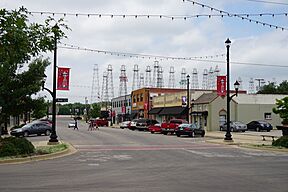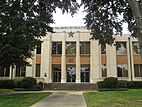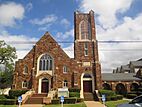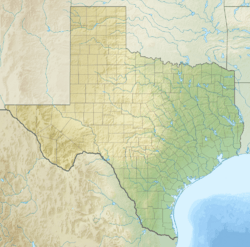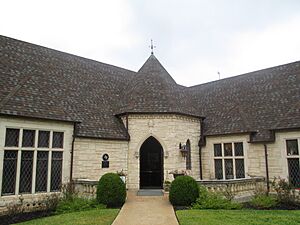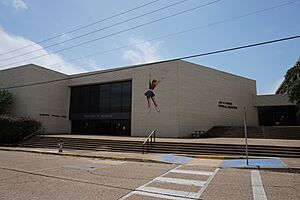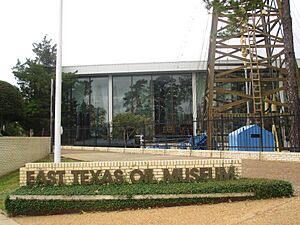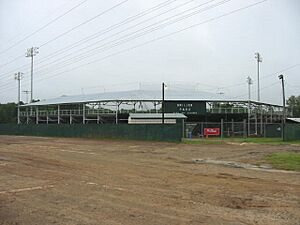Kilgore, Texas facts for kids
Quick facts for kids
Kilgore, Texas
|
|||
|---|---|---|---|
|
World's Richest Acre Park in downtown Kilgore, where the greatest concentration of oil wells in the world once stood
Old Main at Kilgore College
St. Lukes United Methodist Church in downtown Kilgore
|
|||
|
|||
| Country | |||
| State | |||
| Counties | Gregg, Rusk | ||
| Established | 1872 | ||
| Government | |||
| • Type | Council-Manager | ||
| Area | |||
| • Total | 18.65 sq mi (48.29 km2) | ||
| • Land | 18.61 sq mi (48.20 km2) | ||
| • Water | 0.04 sq mi (0.09 km2) | ||
| Elevation | 351 ft (107 m) | ||
| Population
(2020)
|
|||
| • Total | 13,376 | ||
| • Density | 798.02/sq mi (308.12/km2) | ||
| GDP (of MSA) | |||
| • Metro | $20.259 billion (2022) | ||
| Time zone | UTC-6 (Central (CST)) | ||
| • Summer (DST) | UTC-5 (CDT) | ||
| ZIP codes |
75662-3
|
||
| Area code(s) | 903, 430 | ||
| FIPS code | 48-39124 | ||
| GNIS feature ID | 2411541 | ||
Kilgore is a city in Texas, United States. It is located in Gregg and Rusk counties. The city is found where Interstate 20 and US 259 roads meet, just south of the Sabine River. Most of Kilgore is in Gregg County. In 2020, about 13,376 people lived here.
Kilgore first grew because major railroad lines were built through the area. These railroads helped transport important goods like cotton, cattle, and later, oil, from North and East Texas.
Contents
History of Kilgore
Kilgore began in 1872 when the International–Great Northern Railroad finished building a railway line. This line connected Palestine and Longview. The railroad company decided to create a new town instead of going through an older community nearby. They bought land from Constantine B. Kilgore, who the town is named after. This allowed the railroad to make money from selling and developing the land.
A post office opened in Kilgore in 1873. With a train station, it became easier to transport farm products to markets. Soon, people and businesses moved to Kilgore from the older town of New Danville. By 1885, about 250 people lived in Kilgore. The town had two places to process cotton, a church, and a school. By 1914, Kilgore had two banks, many businesses, and about 700 residents. By 1929, the population grew to about 1,000 people.
However, times became tough for Kilgore. The price of cotton, which was a big part of the town's economy, dropped sharply. The Great Depression also hit hard. Businesses started to close. By mid-1930, the population had fallen to 500. It looked like Kilgore might become a ghost town.
Kilgore's luck changed completely on October 3, 1930. A person looking for oil, named Columbus M. "Dad" Joiner, found oil near the nearby town of Henderson. This discovery, called the Daisy Bradford #3 well, led to the huge East Texas Oil Field. Almost overnight, Kilgore changed from a small farming town to a busy "boomtown." Many more oil wells were drilled, including the Lou Della Crim No. 1. By 1936, the population had grown to more than 12,000 people. Kilgore's skyline was filled with oil derricks.
Oil production continued very quickly in the early 1930s. At the peak of the oil boom, there were over 1,100 oil wells working within the city limits. This fast growth made it hard for city services to keep up. Kilgore had to officially become a city in 1931 to manage everything. Many workers came to the city, and law enforcement had trouble keeping order among the temporary homes and busy places. Sometimes, they even needed help from the Texas Rangers.
By the mid-1930s, the oil boom was mostly over. Many small oil companies sold their wells to larger corporations. The boom ended around 1940. However, oil production has remained very important to Kilgore's economy. The population, which changed a lot in the 1930s, settled at around 10,000 people in the 1950s.
In the 1940s, Kilgore had over 1,000 wooden oil derricks. One area was even called "The world's richest acre." Today, there are 60 steel copies of these derricks in the city, each topped with a star. This is why Kilgore is known as Texas' City of Stars.
Geography and Location
Kilgore is located in southern Gregg County and also extends into Rusk County. U.S. Route 259 goes through the east side of the city. This road leads northeast about 11 miles to Longview and south about 17 miles to Henderson. Kilgore's city limits reach about 3 miles north from the city center to Interstate 20. You can get to Kilgore from Interstate 20 at Exits 583, 587, and 589. Interstate 20 goes east about 69 miles to Shreveport, Louisiana and west about 119 miles to Dallas.
The United States Census Bureau says that Kilgore covers a total area of about 18.65 square miles (48.29 square kilometers). Most of this area is land, with a very small part being water.
Kilgore is in the Piney Woods region, which is known for its forests. It is located south of the Sabine River.
People and Population
| Historical population | |||
|---|---|---|---|
| Census | Pop. | %± | |
| 1880 | 248 | — | |
| 1940 | 6,708 | — | |
| 1950 | 9,638 | 43.7% | |
| 1960 | 10,092 | 4.7% | |
| 1970 | 9,495 | −5.9% | |
| 1980 | 11,331 | 19.3% | |
| 1990 | 11,066 | −2.3% | |
| 2000 | 11,301 | 2.1% | |
| 2010 | 12,975 | 14.8% | |
| 2020 | 13,376 | 3.1% | |
| U.S. Decennial Census | |||
| Race | Number | Percentage |
|---|---|---|
| White (NH) | 7,762 | 58.03% |
| Black or African American (NH) | 1,857 | 13.88% |
| Native American or Alaska Native (NH) | 34 | 0.25% |
| Asian (NH) | 111 | 0.83% |
| Pacific Islander (NH) | 5 | 0.04% |
| Some Other Race (NH) | 32 | 0.24% |
| Mixed/Multi-Racial (NH) | 577 | 4.31% |
| Hispanic or Latino | 2,998 | 22.41% |
| Total | 13,376 |
As of the 2020 United States census, there were 13,376 people living in Kilgore. These people made up 5,060 households and 3,476 families.
In 2000, there were 11,301 people in the city. About 24.6% of the population was under 18 years old. The median age was 36 years. This means half the people were younger than 36 and half were older.
The average income for a household in Kilgore was $43,129. For a family, the average income was $61,765.
Economy and Businesses
In 2023, Kilgore had 309 businesses that were owned by local people. The city also attracted $117 million in new industrial investments.
Orgill, a company that distributes hardware, has a large distribution center in Kilgore.
Arts and Culture
Kilgore is home to the Mount Tabor Indian Community, which is a group that celebrates cultural heritage. The Reel East Texas Film Festival is held here every year.
The Kilgore College Rangerettes were started in 1940. They were the world's first precision drill team, known for their amazing dance routines. The Rangerettes have even performed in the famous Macy's Thanksgiving Day Parade.
The Texas Shakespeare Festival is a yearly summer event that performs plays by Shakespeare. It started in 1986. The Kilgore Public Library was finished in 1939.
The East Texas Pipe Organ Festival honors Roy Perry, a Kilgore resident. He helped install pipe organs in important places like St. Mark's Cathedral and Washington National Cathedral. The annual Kilgore Film Festival began in 1998.
The East Texas Oil Museum shows what life was like during the oil boom in the early 1930s. The Rangerette Showcase and Museum is located at Kilgore College.
Sports and Recreation
R.E. Saint John Memorial Stadium is a large sports stadium in Kilgore. It is mainly used by Kilgore College and the Kilgore Independent School District for football games and other events.
Kilgore has had several professional baseball teams in the past. The Kilgore Drillers played from 1947 to 1950. They played their home games at Driller Park, which was built for them. Other teams included the Kilgore Gushers, Kilgore Rangers, and Kilgore Braves.
The Kilgore Trails System is about 3.5 miles (5.6 kilometers) long. It is designed for people who want to walk, run, or cycle. The trails can be accessed from different parts of the city and go through wooded areas.
Education in Kilgore
Public Schools
Most of Kilgore is part of the Kilgore Independent School District. This district covers parts of both Gregg and Rusk counties. A small part of the city in Gregg County is in the Sabine Independent School District.
Higher Education
Kilgore College is a college located in Kilgore. It is home to the Rangers sports teams and the famous Kilgore College Rangerettes. The college's boundary includes the Kilgore and Sabine independent school districts.
Media and News
Newspapers
The Kilgore News Herald is a newspaper that is published twice a week in the city.
Radio Stations
Kilgore has several radio stations that broadcast different types of music and programs.
| Frequency (MHz) | Call letters | Licensed location | Type | Format |
|---|---|---|---|---|
| 88.7 | KZLO | Kilgore | Translator of | contemporary |
| 96.1 | KKTX-FM | Kilgore | Translator of | Classic Rock |
| 105.3 | K287AJ | Kilgore | Translator of | Classic Hits |
City Services
Transportation
Major Roads
- Interstate 20 connects Kilgore to Dallas.
- Highway 259
- State Highway 31
- State Highway 42
- Texas State Highway 135
Airports
Nearby airports include East Texas Regional Airport (which is open to the public) and Kilgore Airport (which is a private airport).
Public Transportation
GoBus is a regional transit system that provides bus services to Kilgore and other nearby cities.
Healthcare
Allegiance Specialty Hospital of Kilgore is a hospital in the city with 60 beds.
Famous People from Kilgore
Sports Stars
- Lane Johnson (born 1990), a football player who attended Kilgore College.
- Alvin Reed (born 1944), played in the NFL for the Houston Oilers and Washington Redskins.
- James Randel "Randy" Matson (born 1945), an Olympic athlete.
- Demorrio Williams, played football for Kilgore College, the University of Nebraska, and the NFL.
- Ron Shepherd (born 1960), a former outfielder for the Toronto Blue Jays; he went to Kilgore High School.
Music, Acting, and Arts
- Van Cliburn (1934–2013), a very famous piano player who grew up in Kilgore.
- Gussie Nell Davis (1906-1993), created the Rangerettes at Kilgore College in 1940.
- Will Jennings (1944-2024), a composer who wrote music.
- Ally Venable (born 1999), an American blues rock guitar player, singer, and songwriter.
Sister Cities
- Rzhyshchiv, Ukraine
See also
 In Spanish: Kilgore (Texas) para niños
In Spanish: Kilgore (Texas) para niños


